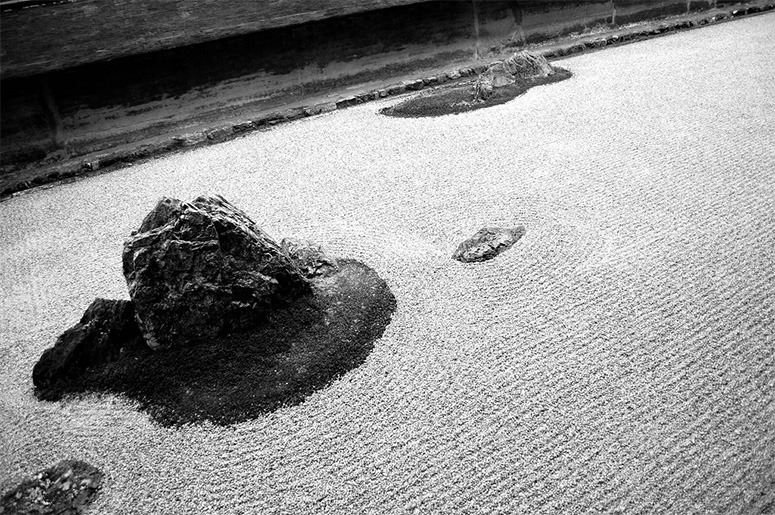
Wybe Kuitert, a notable scholar of Japanese garden history, has challenged the the theory that stone and gravel gardens, like Ryoan-ji, were inspired by Zen Buddhist ideas. He argues that the theory did not appear before the 1930s and that it then arose from an American scholar (Loraine Kuck) who was influenced by Japanese nationalist thinkers who wanted to argue that Japanese culture was more harmonious and less aggresive than western culture. I am persuaded by Kuitert’s account of the origins of the now-common classification of Ryoan-ji but doubtful that his alternative explanation is adequate. From a knowledge of Japan which is much less than Kuitert’s, it appears to me that (1) stone-and-gravel gardens are very likely to have been influenced by Chinese precedents (2) whether or not the Chinese precedents were specifically Chan (ie Zen) Buddhist, they were certainly influenced by Buddhist ideas and their Daoist parallels.
There are three difficulties in tracing the Chinese precedents of stone-and-gravel gardens: (1) so far as I know, there are no visual or records (2) there may be textual records of Buddhist gardens in Song China but, if so, they would have to be investigated by Chinese garden historians with the ability to find and read the relevant documents (3) research into the influence of Buddhism on Chinese gardens is not a popular field of research in China – because Chinese governments have very often wanted to downplay the influence of all foreigners on Chinese civilization.
I hope these questions will receive the attention they deserve someday. Here are some quotations from Kuitert to stimulate the necessary research (from Kuitert, W., Themes in the History of Japanese Garden Art University of Hawaii Press 2002). But, for what it is worth, my view is that the categorization ‘Zen Buddhist Garden’ is valid- unless and until better information becomes available.
p.130 ‘The Oriental supposedly sees himself not as an individual at war with his environment but rather as fundamentally a part of all that is about him.’
p.133 In previous chapters we have seen that the medieval garden makers were not devoted Zen priests but usually menial stoneworkers…
P.133 The present pages on the evolution of a scenic garden style, however, show that this is not the only interpretation. From the preceding it is clear that this type of garden stemmed in theory (and at least part of its practice) from the Chinese intellectual and literary canon of landscape art. The building of a garden was calculated intellectual activity, not an instantaneous act of religiously inspired intuition. It found its place in Zen temples and warrior residences because it enhanced a cultural ambiance. That its appreciation involved religious aspects rather than artistic ones is questionable. A Zen religious experience was interpreted in modern European terms of philosophy by Nishida. It was Suzuki who extended this interpretation to culture and the arts – thereby making the mistake of explaining the intent of the original creator of historical works of art with it. Kuck similarly stated that the Ryoan-ji garden is ‘the creation of an artistic and religious soul who was striving… to express the harmony of the universe’. With this statement she assigned the twentieth-century religious or aesthetic experience she felt on seeing the garden to the soul of a medieval garden maker. Kuck mixes her own historically determined interpretation with an old garden that came about in a completely different cultural setting.
The above photograph of Ryoan-ji is courtery jpellgen. It captures the aspect of the garden which attracts and mystifies western visitors: ‘Karesansui. Ryoan-ji in Kyoto has a world famous zen rock garden. Here you can see some of the simplicity that makes this garden so impressive. The position of the stones and the carefully maintained sand is a sight to behold. Ryoan-ji is a famous temple of the Rinzai branch of Zen Buddhism. It dates back to the 1400’s and was originally associated with the Fujiwara family (big suprise there). The most famous aspect of Ryoan-ji, however, is the karesansui (dry landscape) rock garden–believed to be the finest in the world. It contains 15 stones, although I had trouble finding the last one. Apparently, most people can only see 14 unless you have the right perspective of this 30mx10m garden.’

I am wondering if the question is a little like asking if Communism is Russian, Chinese or Western? Having recently met a young Chinese Buddhist nun travelling in Australia this seems to be a pertinent question. Where does one begin?